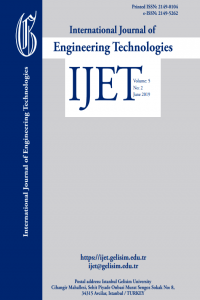Evaluation of Optimal Economic Life of Cemented Carbide Tool Turning AISI4340
Carbide tool, AISI 4340, surface roughness, tool wear,
___
- Aslantas, K., Ucun, I., and Cicek, A.: Back Propagation Algorithm: The Best Algorithm Among the Multi-Layer Perceptron Algorithm, International Journal of Computer Science and Network Security IJCSNS, 9, 442–451, 2009.
- Astakhov, V. P. and Davim, J. P.: Tools (Geometry and Material) and Tool Wear, in: Machining Fundamentals and Recent Advances, edited by Davim, J. P., Springer Verlag Publisher, London, 2008.
- Mandal, N., Doloi, B., and Mondal, B.: Predictive Modeling of Surface Roughness in High Speed Machining of AISI4340 Steel Using Yttria Stabilized Zirconia Toughened Alumina Turning Insert, International Journal of Refractory Metals and Hard Materials, 38, 40–46, 2013.
- Kayhan, M. and Budak, E.: An Experimental Investigation of Chatter Effects on Tool Life, Journal of Engineering Manufacture – Proceedings of the Institute of Mechanical Engineering (IMechE), 223, 1455–1463, 2009.
- Lyman, T.: Metals Handbook, American Society of Metals, Metals Park, Ohio 44073, 8th edn., 1997.
- Shihab, S. K., Khan, Z., Mohammad, A., and Siddiquee, A.: A Review of Turning of Hard Steels Used in Bearing and Automotive Applications, Production and Manufacturing Research: An Open Access Journal, 2, 24–49, 2014.
- Josh, A. and Rampal, R.: Effect of Cutting Parameters on Tool Wear of Coated Carbide Tool in Hard Turning of AISI4340, International Journal of Engineering Sciences and Research Technology, 3, 112–117, 2014.
- de Lima, J., de Avila, R. F., and Abrao, A. M.: Turning of Hardened AISI 4340 Steel Using Coated Carbide Inserts, Proceedings of Institution of Mechanical Engineering: Engineering Manufacture, 221, 1359–1366, 2007.
- Suresh, R., S. Basavarajappa, V. N. G., and Samuel, G. L.: Machinability Investigations on Hardened AISI 4340 Steel Using Coated Carbide Insert, International Journal of Refractory Metals and Hard Materials, 33, 75–86, 2012.
- Coelho, R. T., Ng, E., and Elbestawi, M. A.: Tool Wear When Turning Hardened AISI 4340 with Coated PCBN Tools Using Finishing Cutting Conditions, International Journal of Machine Tools and Manufacture, 47, 263–272, 2007.
- Arsecularane, J. A., Zhang, L. C., 10 and Montross, C.: Wear and Tool Life of Tungsten Carbide, PCBN and PCD Cutting Tools, International Journal of Machine Tools and Manufacture, 46, 482–491, 2006.
- Wilson, F. W.: Fundamentals of Tool Design, Prentice-Hall of India Private Limited, New Delhi, India, 1997.
- Johnson, J. L., Runyon, G., and Morton, C.: Powder Power, Cutting Tool Engineering, 60, 112–117, 2008.
- Astakhov, V. P.: The Assessment of Cutting Tool Wear, International Journal of Machine Tools and Manufacture, 44, 2004.
- Ezugwu, E. O., Olajire, K. A., and Bonney, J.: Modelling of Tool Wear Based on Component Forces, Tribology Letters, 11, 55–60, 2001.
- Awopetu, O. O., Dahunsi, O. A., and Aderoba, A. A.: Selection of Cutting Tool for Turning _ - Titanium Alloy BT5, Assumption University Journal of Technology, 9, 46–52, 2005.
- Bhuiyan, M. S. H., Choudhury, I. A., and Dahari, M.: Monitoring the ToolWear, Surface Roughness and Chip Formation Occurrences Using Multiple Sensors in Turning, Journal of Manufacturing Systems, 33, 476–487, 2014.
- Yaldiz, S. and Unsacar, F.: A Dynamometer Design for Measurement the Cutting Forces on Turning, Measurement, 39, 80–89, 2006.
- Sahoo, A. K. and Sahoo, B.: Experimental Investigation on Machinability aspects in Finish Hard Turning of AISI4340 Steel Using Uncoated and Multilayer Coated Carbide Inserts, Measurement, 45, 2153–2165, 2012.
- Davies, J. R.: Metals Handbook, American Society of Metals, Metals Park, Ohio 44073, desk edn., 1998.
- Hughes, J. I., Sharman, A. R. C., and Ridgway, K.: The Effect of Cutting Tool Material and Edge Geometry on Tool Life and Workpiece 30 Surface Integrity, Journal of Engineering Manufacture: Proceedings of the Institute of Mechanical Engineers, 220, 93–107, 2006.
- Li, B.: A Review of Tool Wear Estimation Using Theoretical Analysis and Numerical Simulation Technologies, International Journal of Refractory Metals and Hard Materials, 35, 143–115, 2012.
- Babu, B. V. and Karthik, S.: Genetic Programming for Symbolic Regression of Chemical Process Systems, Engineering Letters, 14, 1–14, 2007.
- Werner, K. A.: In-Process Monitoring of Cutting Tool Forces, Biennial International Machine Tool Technical Conference, 4, 11.83–11.99, 1984.
- Zhang, S., J. F. Li, J. X. D., and Li, Y. S.: Investigation on Diffusion Wear During High-Speed Machining Ti-6Al-4V Alloy With Straight Tungsten Carbide Tools, International Journal of Advanced Manufacturing Technology, 44, 17–25, 2009.
- ISSN: 2149-0104
- Başlangıç: 2015
- Yayıncı: İstanbul Gelişim Üniversitesi
Ikpe Aniekan E., Orhorhoro Ejiroghene Kelly, Gobir Abdulsamad
Chijioke OKECHUKWU, Olurotimi Akintunde DAHUNSİ, Peter Kayode OKE, İsiaka Oluwole OLADELE, Mohammed DAUDA
Olurotimi Akintunde DAHUNSİ, Olayinka Oladele AWOPETU, Tunde İsaac OGEDENGBE, Tiamiyu İshola MOHAMMED, Taiwo Micheal ADAMOLEKUN
